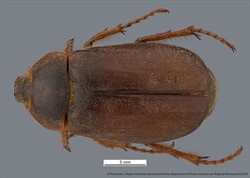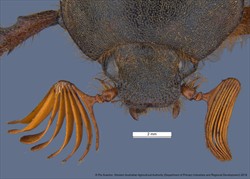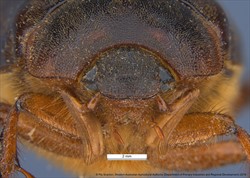Sub family: Melolonthinae / Tribe: Melolonthini / Genus: Rhopaea
Fact Sheet
Rhopaea Erichson, 1847
Medium to large beetles, body length 19-30mm. Body colouration typically yellowish brown to dark brown. Body covered in short setae, densely covering metasternal areas. Scales never present. Anterior and posterior borders of pronotum bearing long fringes of setae, overlapping onto frons and scutellum. Antennae 10 segmented with a 5-8 segmented lammelate club that are significantly longer in males. Anterior face of the clyeus pushed back, allowing labrum to commonly be viewed from above, covered in setal bearing punctations over its entire surface. Clypeal apex appearing subquadrate with rounded edges, sometimes slightly emarginate. Abdominal ventrites with sutural lines diffused medially. Tarsal claws with a median tooth.
Larvae of some Rhopaea species, particularly R. magnicornis, are root feeding pests of pastures, sugarcane, peanut, pineapple, wheat, glycine and hoop pine (Araucaria cunninghamii). Sugarcane damage can also spread into the base of the stalks.
Adult beetles do not feed. Females usually remain at their place of emergence and emit pheromones to attract the males. Females are hence much less commonly collected.
Rhopaea are only known from Australia, ranging from Queensland to South Australia.
Rhopaea magnicornis PaDIL image sets: http://www.padil.gov.au/pests-and-diseases/pest/main/135694
Britton, E.B. 1978. A revision of the Australian chafers (Coleoptera: Scarabaeidae: Melolonthinae) Vol. 2. Tribe Melolonthini. Australian Journal of Zoology, Supplementary Series 60, 1–150.
Chadwick, C.E. 1970. Some aspects of the life history and ecology of Rhopaea magnicornis (Coleoptera: Scarabaeidae). Proceedings of the Linnean Society of New South Wales 95, 11–25.
Miller, L., Allsopp, P. 2000. Identification of Australian canegrubs (Coleoptera: Scarabaeidae: Melolonthini). Invertebrate Taxonomy Vol 14: 377-409.







